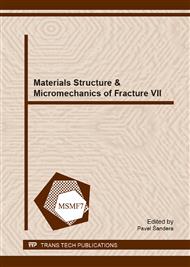p.301
p.307
p.313
p.317
p.321
p.325
p.329
p.335
p.342
Details of the Formation of Superstructures in the Process of Ordering in Cu-Pt Alloys
Abstract:
Alloys of Cu-Pt [1] are of interest for research, since the phase transitions "order - disorder" at different concentrations of components form several types of superstructures. In the alloy Cu3Pt the ordering L12 superstructure formed on the basis of fcc lattice. In the ordering of the fcc lattice of the disordered solid solution the equiatomic composition transformed into the L11 superstructure with an rhombohedral crystal lattice (a state with an L11, whose angles α, β, and γ are other than π/2). A CuPt3 in an ordered state has an L13 superstructure (a state with an L13, whose angles α, β, and γ are other than π/2). A possible existence of an ordered phase containing 20 at.% Pt was reported in the literature [2], which corresponds to the composition of Cu4Pt (type of superstructure was not defined). In other sources, an occurrence of an ordered compound, Cu7Pt, was predicted, containing 12.5 at.% Pt [3]. Computer experiments performed on the Monte Carlo method, showed that the alloys of the Cu - Pt different composition components undergo phase transformations "disorder - order" from the FCC to the structures of different symmetry [4,11]. This paper presents the results of a study of the structural transformations in the alloys Cu3Pt, CuPt, CuPt3 (superstructure L12, L11, L13), containing shear antiphase boundaries (APB) in the planes {111}.
Info:
Periodical:
Pages:
321-324
Citation:
Online since:
November 2013
Price:
Сopyright:
© 2014 Trans Tech Publications Ltd. All Rights Reserved
Share:
Citation:


